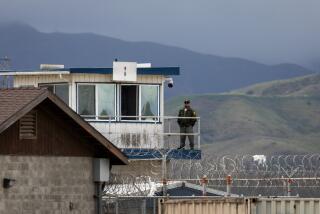Yes, Look at the Lower Crime Rate
California’s three-strikes law, which imposes mandatory sentences of 25 years to life for those convicted of third felonies, is regarded as the nation’s toughest sentencing law. Yet while supporters attribute the drop in violent crimes and homicides to the controversial law, a study released recently by University of California researchers found no evidence it is a deterrent to crime. According to the study, almost 50,000 felons have been sent to prison under the law since 1994. MAURA E. MONTELLANO spoke with Mike Reynolds, the law’s co-author and father of a murdered woman, and Keith Morgan, an inmates’ advocate.
*
This was not an issue of revenge. There was nothing I could do to save my daughter’s life. It was a helpless feeling. It was a promise I had made to her that if I couldn’t save her life, I would try to keep this from happening to other people. None of this was done out of revenge or anger but out of frustration with a system that was allowing the same criminals to essentially recommit the same crimes over and over again.
The first year of the law, there clearly was court clogging and it was anticipated. It was called a sweeps year. It made believers out of a lot of criminals of this state. That early year surge has now produced a lower caseload in our courts than we have ever seen. People must understand that 60% to 80% of all crimes are committed by the same people. We’re removing those people from this system, giving them longer sentences and not seeing them come through the court system again. Three strikes has the escape clause at the beginning when the prosecutor decides to charge or not. The judge also has the opportunity to reduce charges. There is considerable thought that is made and given to charge and prosecute under a three-strikes formula. While no law is perfect, this law comes closer to being perfect than any other law to date.
There are a lot of costs when you put someone through the court process. We’ve eliminated those court costs. Most people do not realize that it takes $1.5 million to process a murder case. But if a murder doesn’t occur, if we don’t let things get to that point, we don’t have to spend that kind of money.
Five years prior to three strikes’ enactment, the California prison system increased by 51%, but five years after the law, it increased only 31%. According to pre-three-strikes estimates, California would have had 245,000 inmates in the system, and would have needed 20 new prisons to accommodate the surge of inmates. Instead, today we house just 161,000 inmates and haven’t looked to build any new prisons since the passage of three strikes. There have been private facilities built, but they have not been staffed or opened to inmates.
There are several ways to measure the success of a crime law. Fewer crimes equals fewer investigations, arrests, convictions and incarcerations. In Los Angeles, within the first two years of the law, there was a one-third drop in the arrest rate. Crime in California is dropping at twice the rate of crime nationally.
The bottom line is: If you’re not prepared to lock up criminals, you’re not going to stop crime. I think there are many people who are very repentant for what they have done. I would ask, though, if they were sorry because they got caught or for the grief and damage that they left with the victims’ families.Once someone has had two serious or violent convictions, the question is, who do we give the next chance to? I vote in favor of the next victim.
More to Read
Sign up for Essential California
The most important California stories and recommendations in your inbox every morning.
You may occasionally receive promotional content from the Los Angeles Times.










